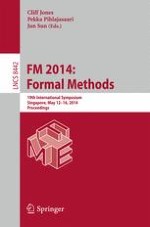This book constitutes the refereed proceedings of the 19th International Symposium on Formal Methods, FM 2014, held in Singapore, May 2014. The 45 papers presented together with 3 invited talks were carefully reviewed and selected from 150 submissions. The focus of the papers is on the following topics: Interdisciplinary Formal Methods, Practical Applications of Formal Methods in Industrial and Research Settings, Experimental Validation of Tools and Methods as well as Construction and Evolution of Formal Methods Tools.
